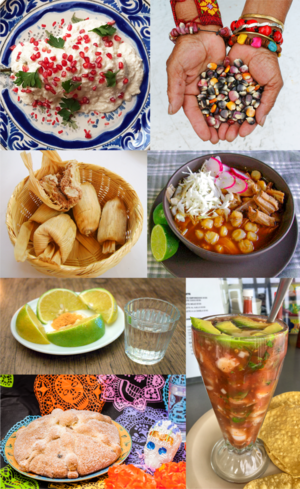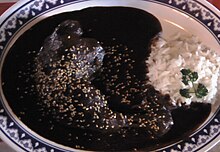
Back مطبخ مكسيكي Arabic Meksika mətbəxi Azerbaijani Ajengan Méksiko BAN Мексіканская кухня Byelorussian Мэксыканская кухня BE-X-OLD Мексиканска кухня Bulgarian Gastronomia de Mèxic Catalan Mexická kuchyně Czech Det mexicanske køkken Danish Mexikanische Küche German

| Part of a series on the |
| Culture of Mexico |
|---|
 |
| Society |
| Topics |
| Symbols |

Mexican cuisine consists of the cooking cuisines and traditions of the modern country of Mexico. Its earliest roots lie in Mesoamerican cuisine. Its ingredients and methods begin with the first agricultural communities such as the Olmec and Maya who domesticated maize, created the standard process of nixtamalization, and established their foodways.[2] Successive waves of other Mesoamerican groups brought with them their cooking methods. These included: the Teotihuacanos, Toltec, Huastec, Zapotec, Mixtec, Otomi, Purépecha, Totonac, Mazatec, Mazahua, and Nahua. With the Mexica formation of the multi-ethnic Triple Alliance (Aztec Empire), culinary foodways became infused (Aztec cuisine).
Today's food staples native to the land include corn (maize), turkey, beans, squash, amaranth, chia, avocados, tomatoes, tomatillos, cacao, vanilla, agave, spirulina, sweet potato, cactus, and chili pepper. Its history over the centuries has resulted in regional cuisines based on local conditions, including Baja Med, Chiapas, Veracruz, Oaxacan, and the American cuisines of New Mexican and Tex-Mex.
After the Spanish Conquest of the Aztec empire and the rest of Mesoamerica, Spaniards introduced a number of other foods, the most important of which were meats from domesticated animals (beef, pork, chicken, goat, and sheep), dairy products (especially cheese and milk), rice, sugar, olive oil and various fruits and vegetables. Various cooking styles and recipes were also introduced from Spain both throughout the colonial period and by Spanish immigrants who continued to arrive following independence. Spanish influence in Mexican cuisine is also noticeable in its sweets such as: alfajores, alfeniques, borrachitos and churros.
African influences was also introduced during this era as a result of African slavery in New Spain through the Atlantic slave trade and the Manila-Acapulco Galleons.[3]
Mexican cuisine is an important aspect of the culture, social structure and popular traditions of Mexico. The most important example of this connection is the use of mole for special occasions and holidays, particularly in the South and Central regions of the country. For this reason and others, traditional Mexican cuisine was inscribed in 2010 on the Representative List of the Intangible Cultural Heritage of Humanity by UNESCO.[4]
- ^ a b "El mole símbolo de la mexicanidad" (PDF). CONACULTA. Retrieved 27 September 2016.
- ^ "Civilization.ca - Mystery of the Maya". www.historymuseum.ca. Retrieved 1 February 2021.
- ^ "La cocina del virreinato". CONACULTA. Retrieved 13 January 2015.
- ^ "Traditional Mexican cuisine - ancestral, ongoing community culture, the Michoacán paradigm". UNESCO. Retrieved 13 January 2015.
© MMXXIII Rich X Search. We shall prevail. All rights reserved. Rich X Search